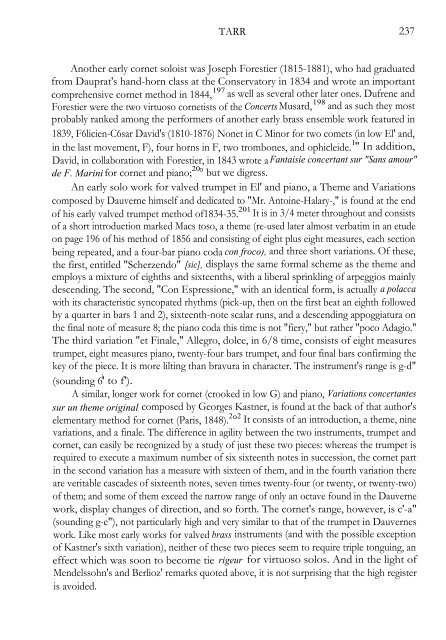THE ROMANTIC TRUMPET - Historic Brass Society
THE ROMANTIC TRUMPET - Historic Brass Society
THE ROMANTIC TRUMPET - Historic Brass Society
You also want an ePaper? Increase the reach of your titles
YUMPU automatically turns print PDFs into web optimized ePapers that Google loves.
TARR 237<br />
Another early cornet soloist was Joseph Forestier (1815-1881), who had graduated<br />
from Dauprat's hand-horn class at the Conservatory in 1834 and wrote an important<br />
comprehensive cornet method in 1844, 197 as well as several other later ones. Dufrene and<br />
Forestier were the two virtuoso cornetists of the Concerts Musard, 198 and as such they most<br />
probably ranked among the performers of another early brass ensemble work featured in<br />
1839, F6licien-C6sar David's (1810-1876) Nonet in C Minor for two comets (in low El' and,<br />
in the last movement, F), four horns in F, two trombones, and ophicleide. 1 " In addition,<br />
David, in collaboration with Forestier, in 1843 wrote a Fantaisie concertant sur "Sans amour"<br />
de F. Marini for cornet and piano; 20 ° but we digress.<br />
An early solo work for valved trumpet in El' and piano, a Theme and Variations<br />
composed by Dauverne himself and dedicated to "Mr. Antoine-Halary-," is found at the end<br />
of his early valved trumpet method of1834-35. 201 It is in 3/4 meter throughout and consists<br />
of a short introduction marked Macs toso, a theme (re-used later almost verbatim in an etude<br />
on page 196 of his method of 1856 and consisting of eight plus eight measures, each section<br />
being repeated, and a four-bar piano coda con froco), and three short variations. Of these,<br />
the first, entitled "Scherzendo" [sic], displays the same formal scheme as the theme and<br />
employs a mixture of eighths and sixteenths, with a liberal sprinkling of arpeggios mainly<br />
descending. The second, "Con Espressione," with an identical form, is actually a polacca<br />
with its characteristic syncopated rhythms (pick-up, then on the first beat an eighth followed<br />
by a quarter in bars 1 and 2), sixteenth-note scalar runs, and a descending appoggiatura on<br />
the final note of measure 8; the piano coda this time is not "fiery," but rather "poco Adagio."<br />
The third variation "et Finale," Allegro, dolce, in 6/8 time, consists of eight measures<br />
trumpet, eight measures piano, twenty-four bars trumpet, and four final bars confirming the<br />
key of the piece. It is more lilting than bravura in character. The instrument's range is g-d"<br />
(sounding 6 1 ' to f').<br />
A similar, longer work for cornet (crooked in low G) and piano, Variations concertantes<br />
sur un theme original composed by Georges Kastner, is found at the back of that author's<br />
elementary method for cornet (Paris, 1848). 2 ° 2 It consists of an introduction, a theme, nine<br />
variations, and a finale. The difference in agility between the two instruments, trumpet and<br />
cornet, can easily be recognized by a study of just these two pieces: whereas the trumpet is<br />
required to execute a maximum number of six sixteenth notes in succession, the cornet part<br />
in the second variation has a measure with sixteen of them, and in the fourth variation there<br />
are veritable cascades of sixteenth notes, seven times twenty-four (or twenty, or twenty-two)<br />
of them; and some of them exceed the narrow range of only an octave found in the Dauverne<br />
work, display changes of direction, and so forth. The cornet's range, however, is c'-a"<br />
(sounding g-e"), not particularly high and very similar to that of the trumpet in Dauvernes<br />
work. Like most early works for valved brass instruments (and with the possible exception<br />
of Kastner's sixth variation), neither of these two pieces seem to require triple tonguing, an<br />
effect which was soon to become tie rigeur for virtuoso solos. And in the light of<br />
Mendelssohn's and Berlioz' remarks quoted above, it is not surprising that the high register<br />
is avoided.
















